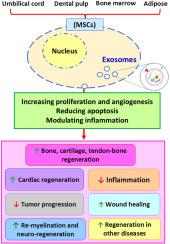Regenerative medicine and tissue engineering potential of mesenchymal stem cells exosomes-derived microRNAs
IF 2.6
3区 生物学
Q4 CELL BIOLOGY
引用次数: 0
Abstract
Mesenchymal stem cells (MSCs) have been revealed as an appropriate candidate for cell-based therapies by isolation from a different range of sources such as bone marrow, umbilical cord, adipose, liver, and orofacial tissues. MSCs showed low immunogenicity, which is considered as a potential alternative therapy for autoimmune and inflammatory diseases. Transplantation of MSCs in different research studies showed that it improves the repairment and regeneration of injured and impaired tissues. MSCs release biologically active molecules, such as extracellular vehicles (EVs) and exosomes (EXOs). EXOs participate in different physiological processes, including immune response, wound healing, bone repair, stem cell maintenance, interaction between the central nervous system (CNS), and pathological impacts in tumorigenesis, inflammation, and heart diseases. Across the tissues, MSCs release exosomes and regenerative molecules and transfer proteins, mRNAs and microRNAs. MicroRNAs (miRNAs) are small noncoding RNAs (21–23 nt) in length that bind to the 3′ untranslated region (3′UTR) of target mRNA and post-transcriptionally regulate gene expression that affects different cellular pathways. More studies are needed relating to the exosome's biogenesis, cellular uptake, trafficking, isolation, qualification, purity, optimization, standardization, and molecular mechanisms of exosome connection with target cells. Recent studies reported promising applications of exosomes derived from various sources in regenerative medicine and tissue engineering approaches. Herein, we are more focused on studies with different approaches in regenerative medicine for tissue repair and healing related to bone, cartilage, tendon-bone, heart, nerves, wounds, skin, and tooth regeneration.

间充质干细胞外泌体来源的microrna的再生医学和组织工程潜力
通过从骨髓、脐带、脂肪、肝脏和口面部组织等不同来源中分离出间充质干细胞(MSCs),发现它是一种合适的细胞基治疗候选者。MSCs具有低免疫原性,被认为是自身免疫性疾病和炎症性疾病的潜在替代疗法。不同的研究表明,MSCs的移植可以促进损伤和受损组织的修复和再生。间充质干细胞释放生物活性分子,如细胞外载体(ev)和外泌体(EXOs)。exo参与不同的生理过程,包括免疫反应、伤口愈合、骨修复、干细胞维持、中枢神经系统(CNS)之间的相互作用以及肿瘤发生、炎症和心脏病的病理影响。在整个组织中,MSCs释放外泌体和再生分子,并转移蛋白质、mrna和microrna。MicroRNAs (miRNAs)是一种长度为21 - 23nt的小非编码rna,可结合靶mRNA的3 ‘非翻译区(3 ’ utr),并通过转录后调控影响不同细胞通路的基因表达。关于外泌体的生物发生、细胞摄取、运输、分离、鉴定、纯度、优化、标准化以及外泌体与靶细胞连接的分子机制,还需要进行更多的研究。最近的研究报道了各种来源的外泌体在再生医学和组织工程方法中的应用前景。在此,我们更关注再生医学中与骨、软骨、肌腱-骨、心脏、神经、伤口、皮肤和牙齿再生相关的组织修复和愈合的不同方法的研究。
本文章由计算机程序翻译,如有差异,请以英文原文为准。
求助全文
约1分钟内获得全文
求助全文
来源期刊

Differentiation
生物-发育生物学
CiteScore
4.10
自引率
3.40%
发文量
38
审稿时长
51 days
期刊介绍:
Differentiation is a multidisciplinary journal dealing with topics relating to cell differentiation, development, cellular structure and function, and cancer. Differentiation of eukaryotes at the molecular level and the use of transgenic and targeted mutagenesis approaches to problems of differentiation are of particular interest to the journal.
The journal will publish full-length articles containing original work in any of these areas. We will also publish reviews and commentaries on topics of current interest.
The principal subject areas the journal covers are: • embryonic patterning and organogenesis
• human development and congenital malformation
• mechanisms of cell lineage commitment
• tissue homeostasis and oncogenic transformation
• establishment of cellular polarity
• stem cell differentiation
• cell reprogramming mechanisms
• stability of the differentiated state
• cell and tissue interactions in vivo and in vitro
• signal transduction pathways in development and differentiation
• carcinogenesis and cancer
• mechanisms involved in cell growth and division especially relating to cancer
• differentiation in regeneration and ageing
• therapeutic applications of differentiation processes.
 求助内容:
求助内容: 应助结果提醒方式:
应助结果提醒方式:


